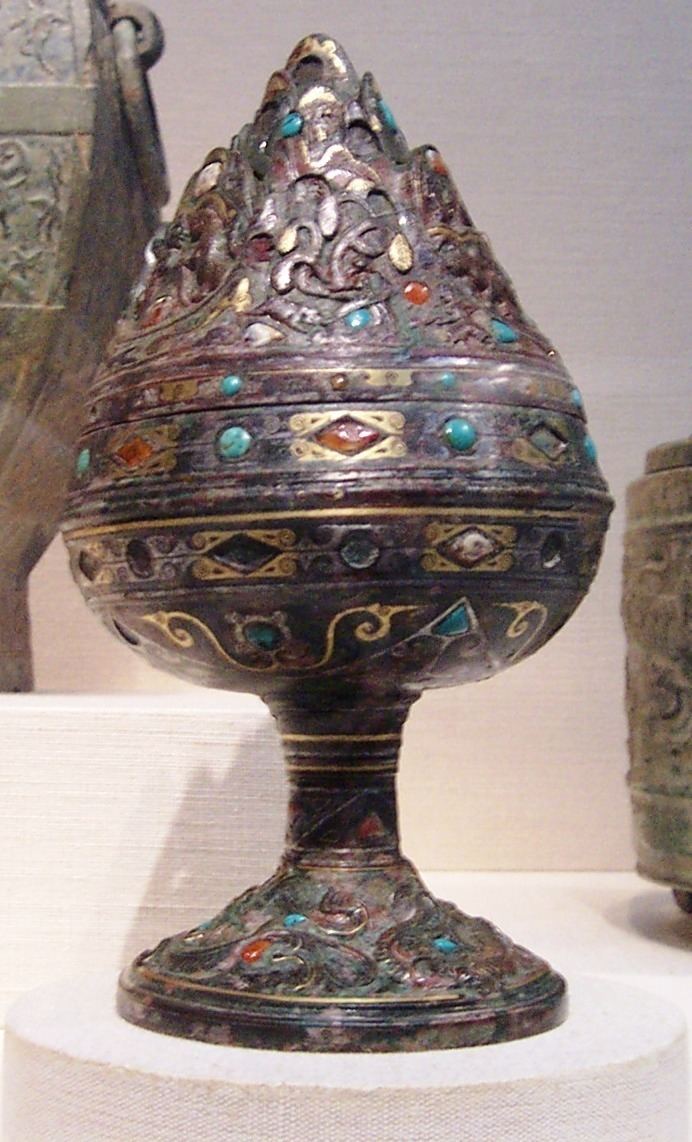 | ||
Incense in China is traditionally used in a wide range of Chinese cultural activities including, religious ceremonies, ancestor veneration, traditional medicine, and in daily life. Known as xiang (Chinese: 香; pinyin: xiāng; Wade–Giles: hsiang; literally: "fragrance"), incense was used by the Chinese cultures starting from Neolithic times with it coming to greater prominence starting from the Xia, Shang, and Zhou dynasties.
Contents
- Chinese censers
- Medicine
- Time keeping
- Religion
- As an art form
- Bamboo processing
- Incense materials
- Processes
- Lin xiang
- Nuo xiang
- Sculpting
- Winding
- References
One study shows that during the Han Dynasty (206 BC – AD 220 ) there was increased trade and acquisitions of more fragrant foreign incense materials when local incense materials were considered "poor man's incense".
It reached its height during the Song Dynasty with its nobility enjoying incense as a popular cultural pastime, to the extent of building rooms specifically for the use of incense ceremonies.
Besides meaning "incense", the Chinese word xiang (香) also means "fragrance; scent; aroma; perfume; spice". The sinologist and historian Edward H. Schafer said that in medieval China:
Chinese censers
Words meaning "censer; incense burner" are compounds of lu (爐 or 炉) "brazier; stove; furnace", which was a category of ancient Chinese bronzes. Xianglu (香爐, with "incense") means "incense burner; censer" in general. Xunlu (熏爐, with "smoke; fumigate; cure (food) with smoke", or 薰爐, with "fragrance (of plants); an aromatic grass, Eupatorium fortunei") means "small censer, esp. for fumigating or scenting clothing". Shoulu (手爐, with "hand") means "hand-held censer; handwarmer; portable charcoal stove".
The boshanlu (博山爐 "universal mountain censer"), which became popular during the era of Emperor Wu of Han (r. 141 - 87 BC), displayed a microcosmic sacred mountain (esp. Mount Kunlun or Mount Penglai). These elaborate censers were designed with apertures that made rising incense smoke appear like clouds or mist swirling around a mountain peak.
Medicine
Similar ingredients and processing techniques are involved in production of both incense and Traditional Chinese medicines. For example, take jiu (灸 "moxibustion"). Incense is believed to have physiological and psychological benefits. For instance, according to the Bencao Gangmu pharmacopoeia, "camphor cured evil vapors in heart and belly, and was especially recommended for eye troubles, including cataract."
Time-keeping
Along with the introduction of Buddhism in China came calibrated incense sticks and incense clocks (xiangzhong 香鐘 "incense clock" or xiangyin 香印 "incense seal"). The poet Yu Jianwu (庾肩吾, 487-551) first recorded them: "By burning incense we know the o'clock of the night, With graduated candles we confirm the tally of the watches." The use of these incense timekeeping devices spread from Buddhist monasteries into secular society.
Religion
Xiangbang (香棒, with "stick; club") means "incense stick; joss stick". Two "incense" synonyms specifying religious offerings to ancestors or deities are gāoxiāng (高香, "high incense") and gōngxiāng (供香, "offering incense").
The Sunni Muslim Hui Gedimu and the Yihewani burned incense during worship. This was viewed as Daoist or Buddhist influence. The Hui, also known as "White-capped HuiHui", used incense during worship, while the Salar, also known as "black-capped HuiHui" considered this to be a heathen ritual and denounced it.
As an art form
The Chinese developed a sophisticated art form with incense burning like with tea and calligraphy called xiangdao ( 香道). It involves various paraphernalia and utensils in various ceramic containers utilised to burn incense. Examples include tongs, spatulas, special moulds to create ideograms with incense powder, etc. all placed on a special small table. It is most often used as an enhancement to a personal space to accompany other arts such as tea drinking and guqin playing.
Bamboo processing
Bamboo species with good burning characteristics are harvested and dried. The most common type of bamboo used for producing the sticks is Phyllostachys heterocycla cv. pubescens (茅竹,江南竹) since this species produces thick wood and easily burns to ashes in the incense stick. Other types of bamboos such as Phyllostachys edulis (毛竹) may be used, however due to their fiberous surfaces or relatively thin wood producing good bamboo sticks is more difficult. Longer incense stick are produced using cao bamboo(草竹).
The dried bamboo poles of around 10 cm in diameter are first manually trimmed to length, soak, peeled, and then continuously split in halves until thin sticks of bamboo with square cross sections of less than 3mm width have been produced. This process has largely been replaced by machines in modern incense production.
Incense materials
Chinese incense is made from diverse ingredients with much overlap into the traditional Chinese herbal pharmacopoeia. Of all the incense ingredients some of the most commonly used include:
The dried powdered bark of Persea nanmu(楠木皮) is used extensively for its mucilaginous qualities, which helps to bind the other powdered ingredients together.
Processes
Incense powder is formed into the final product through various methods.
Lin-xiang
Incense powder is tossed over wet sticks
Nuo-xiang
Incense paste is kneaded around sticks.
Sculpting
For large incense pillars, incense paste is piled around a single bamboo stick and sculpted to shape
Winding
Incense paste is extruded and wound to produce spiral incense
